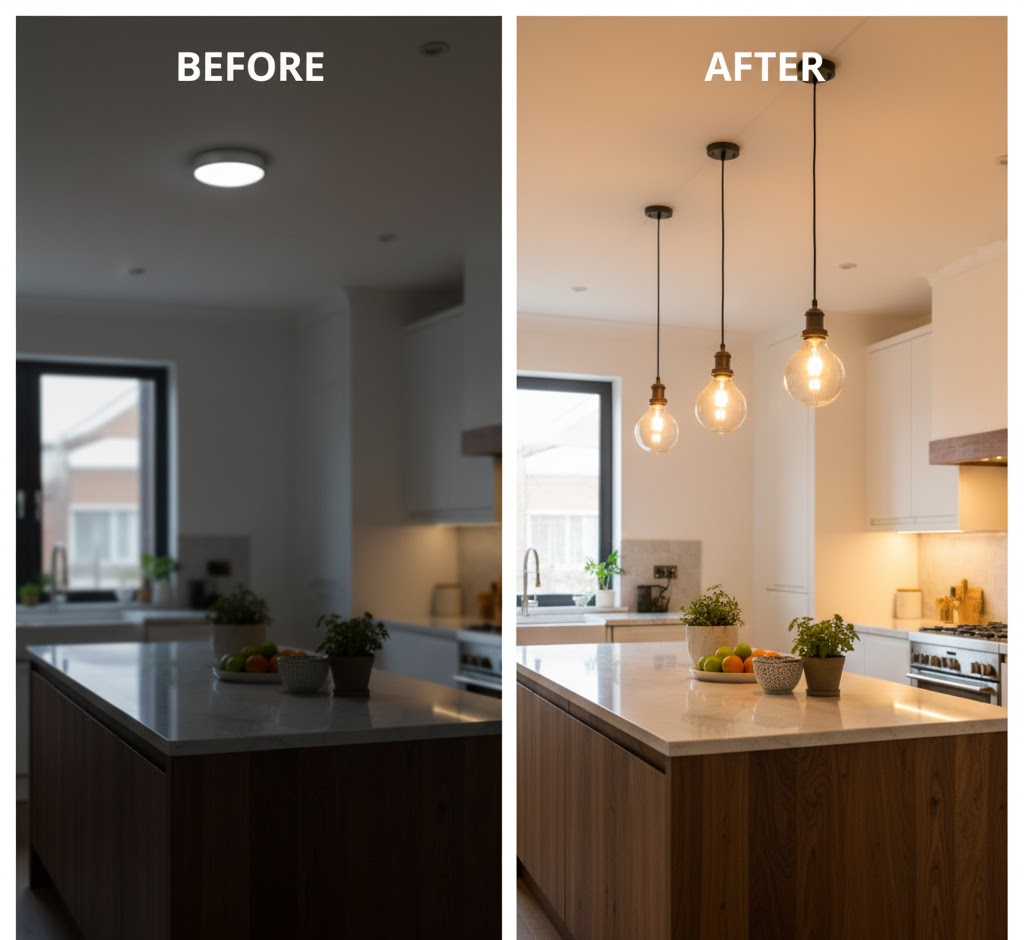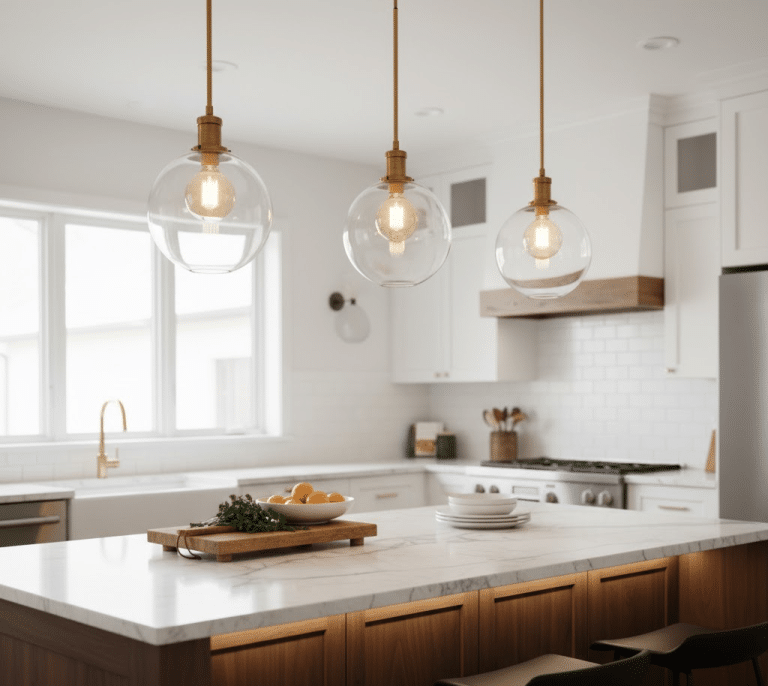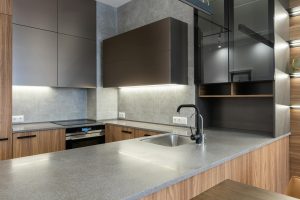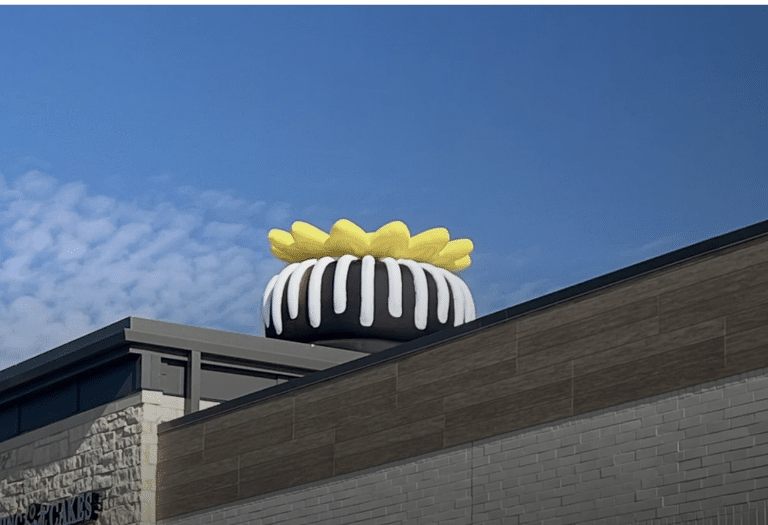In many homes across the United States, the kitchen island has become the real gathering place. It is where cooking, homework, quick breakfasts, and late night conversations all happen in one compact zone. The right kitchen island lighting does more than make the countertop visible, it helps the entire room feel organized, comfortable, and visually balanced.
Below are practical lighting rules for 2025 that any homeowner can follow. You can use these ideas when planning a new kitchen, updating an older space, or simply replacing outdated pendant lights.
Rule 1: Align Lighting To The Island, Not The Room
One of the most common mistakes is centering fixtures on the ceiling layout instead of the island itself. When pendant lights are slightly off center, the whole kitchen can look crooked, even if the cabinets and walls are straight.
How to get the layout right
- Measure the full length and depth of your island.
- Mark the exact center of the island on the countertop with painter’s tape.
- Translate that point to the ceiling and use it as your reference for pendant placement.
If your island is not aligned with the room or ceiling beams, prioritize the island. The eye reads the island and the pendants together as one composition, so that alignment matters most.
Rule 2: Choose The Right Pendant Size And Quantity
Kitchen island lighting often looks odd because the pendants are either too small or too large for the countertop, or there are too many fixtures crowded together. The goal is to frame the island without blocking sight lines.
Simple sizing guidelines
- Small islands (4 to 5 feet long): One medium pendant or two smaller pendants usually works well.
- Medium islands (6 to 7 feet long): Two or three pendants spaced evenly tend to look balanced.
- Large islands (8 feet and longer): Three larger pendants or a linear chandelier can give a clean, unified look.
A common guideline is to leave at least 6 to 8 inches from the end of the island to the first pendant, then use even spacing between fixtures. When in doubt, slightly fewer and slightly larger pendants usually feel calmer than many small ones.
Rule 3: Hang Pendant Lights At A Comfortable Height
Even the nicest fixtures can feel awkward if they hang too high or too low. Too high and the light feels weak. Too low and the pendants block views across the kitchen and into the living area.
Typical pendant mounting height
- Aim for the bottom of the pendant to sit about 30 to 36 inches above the countertop surface.
- For very tall people or homes with high ceilings, lean closer to 36 inches to keep the view clear.
- If you have a cooktop on the island, confirm that pendants do not sit in the way of steam and cooking splatter.
Adjustable rods or cables make it easier to fine tune the height during installation, so consider that feature if you are unsure of the final position.
Rule 4: Match Color Temperature To The Kitchen Mood
The color of the light affects how your countertops, cabinets, and food appear. Kitchen island lighting that is too cold can make the room feel clinical, while extremely warm light can look dull on white stone and modern finishes.
Color temperature tips
- For most kitchens, a range between 2700 K and 3000 K gives a pleasant balance that works with warm and cool materials.
- If your kitchen has a very modern, minimalist design with a lot of white and gray, 3000 K to 3500 K can keep surfaces looking crisp.
- Choose the same color temperature for your pendants, recessed lights, and nearby fixtures so the room does not break into mismatched tones.
In 2025, many homeowners are choosing integrated LED fixtures with a fixed temperature, so it is important to decide on the look you want before ordering.
Rule 5: Plan For Enough Brightness With Multiple Layers

Kitchen island lighting should support prep work, cooking, serving, and casual dining. Pendants alone rarely cover every need. A layered approach gives flexibility without clutter.
Layers that work well together
- Pendants or a linear chandelier: Focused light over the island, styled as the visual highlight.
- Recessed or track lighting: General light for walking paths and the rest of the kitchen.
- Under cabinet lighting: Task light on perimeter countertops, keeping shadows off the workspace.
Aim for enough overall lumens so the room feels bright on cleaning days, then rely on dimmers and scenes to bring the level down for normal evenings.
Rule 6: Coordinate Fixtures With Hardware And Appliances
In open kitchens, pendants sit at eye level from many angles. Clashing metal finishes or styles can make the space feel busy and smaller than it is.
Easy coordination ideas
- Match the main metal of your pendant lights with one of the existing finishes: faucet, cabinet pulls, or appliance trim.
- If you mix metals, keep it intentional. For example, black pendants with brushed nickel hardware and stainless appliances.
- In open concept layouts, make sure kitchen island lighting also looks good from the living room or dining area.
A simple, consistent palette tends to photograph better for real estate listings and social media, which is a bonus many homeowners care about in 2025.
Rule 7: Use Dimmers And Smart Controls For Daily Life
The light level you need at 7 a.m. is not the same as what you want at 9 p.m. during a quiet evening. Fixed brightness can feel harsh or dull at the wrong time of day.
Control that fits modern kitchens
- Install dimmers for your island pendants so you can shift from task mode to relaxed mode easily.
- Consider smart switches or smart bulbs that let you create scenes like “Cooking”, “Dining”, and “Night light” controlled from your phone or voice assistant.
- Keep controls simple for guests and family members who may not use apps. A clear wall switch layout still matters.
Good control makes your lighting plan more useful every day without changing the fixtures themselves.
Quick Checklist For Kitchen Island Lighting In 2025
Before you order or install new fixtures, run through this short list:
- Measure the island and center your layout on the countertop, not the room.
- Choose pendant sizes and quantities that match the island length and keep spacing even.
- Hang fixtures about 30 to 36 inches above the countertop, adjusting for height and views.
- Pick a color temperature between 2700 K and 3500 K that fits your materials and style.
- Plan at least two or three layers of light so the kitchen works for cooking and for relaxing.
- Coordinate fixtures with your hardware and appliances for a unified look.
- Add dimmers or smart controls so the same lights can handle every moment of the day.
Ready To Refresh Your Kitchen Island Lighting?
Thoughtful kitchen island lighting rules make a clear difference in how your home feels and functions. With the right pendants, height, spacing, and control, your island can serve as both a hardworking prep station and a comfortable place to gather.
If you are searching for ideas, styles, and guidance for modern kitchen lighting, you can visit Seus Lighting to see how different fixtures might work in your space and to get a sense of what fits your home and daily routine.













